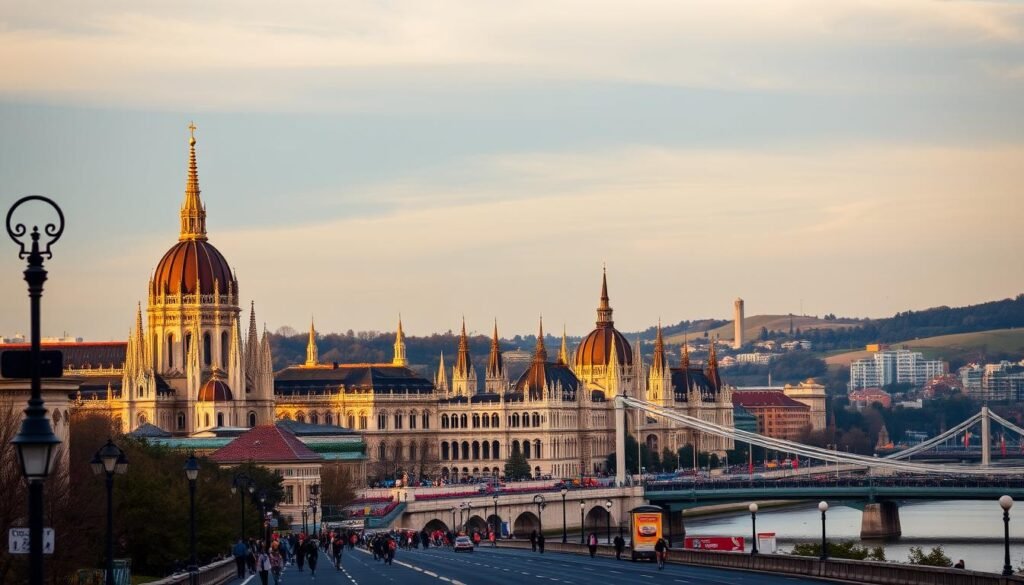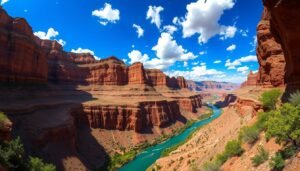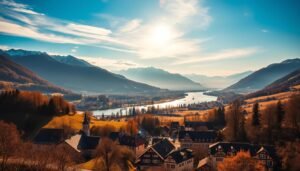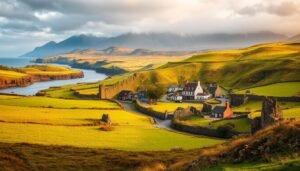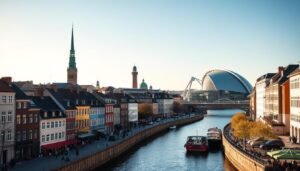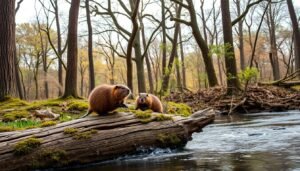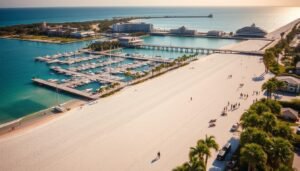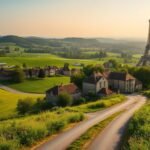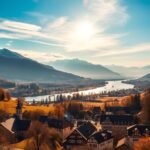Surprising fact: nearly half of the city’s most striking facades date from just three architectural movements, which is why a short walk feels like a living museum.
I plan my days around neighborhoods, not checklists. I walk from Váci Utca through embassy-lined avenues and let szecesszió roofs catch my eye. That approach saved time and let me linger where the detail rewarded pause.
I grouped highlights for a compact trip: sunrise views, solemn memorials, grand tours, warm baths, lively bars, and a market snack that felt like a discovery. I left buffers for photos, coffee stops, and those small detours that become favorite memories.
For a practical primer and more route ideas, see a detailed travel roundup here: my linked guide. Below are quick takeaways to start planning without rushing through the city’s best.
Key Takeaways
- Use neighborhoods as your map to save time and walk more efficiently.
- Look up: many building details hide on facades and tiled roofs.
- Balance dawn and dusk stops for the best light and smaller crowds.
- Pack a flexible two-day plan with room for one unexpected favorite.
- Prioritize a soak at the baths and one lively night at local bars.
- Carry a small cash amount and a transit app for quick moves.
My perfect first day in the city: how I plan my time and route
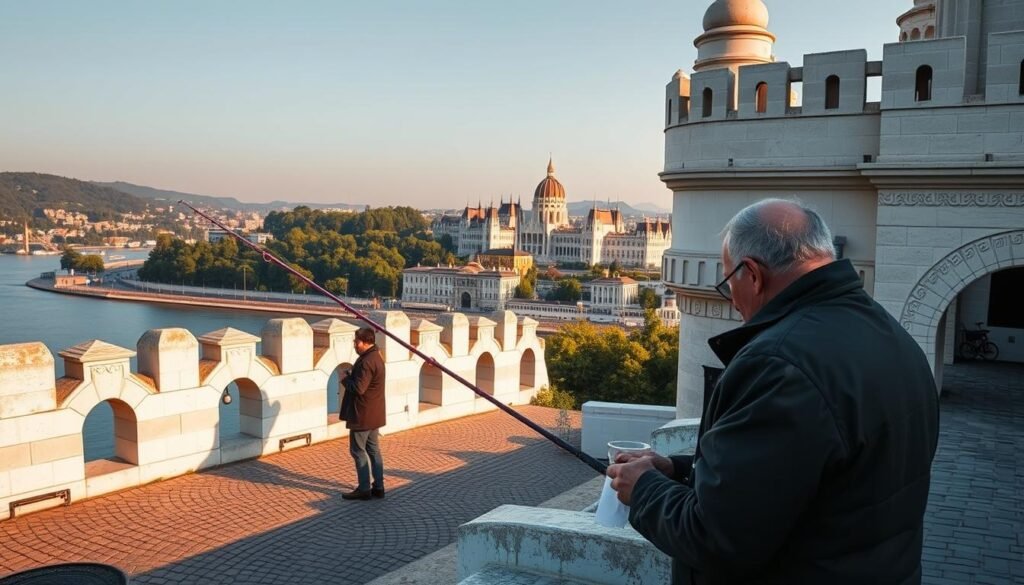
My ideal first day begins before sunrise, when streets feel like a secret kept just for me. I use light and short walks to stitch the highlights into a calm loop. This way I avoid long waits and still see the best views.things-to-do-in-fredericksburg-tx
Morning: sunrise at Fisherman’s Bastion and coffee nearby
I arrived around 7 AM to beat crowds; Fisherman’s Bastion is free to enter, though the highest lookout has a small fee. After a quiet terrace moment, I grabbed coffee at a nearby spot and let the morning light settle on the rooftops.
Midday: Parliament views and the Shoes on the Danube
I used Parliament as my midday anchor, circling for different angles along the waterfront. Then I paused at the Shoes on the Danube memorial and spent a few reflective minutes reading the plaques.
Evening: thermal soak and ruin bar crawl
For evening I booked Széchenyi Baths—the complex has many indoor baths and outdoor pools—so I could reset before heading to the Jewish Quarter. Ruin bars began in the early 2000s; I paced my crawl from lively pioneers to quieter courtyards.
| Part of Day | Timing | Main Focus |
|---|---|---|
| Morning | ~7 AM, 1–2 hours | Fisherman’s Bastion, terrace & coffee |
| Midday | Late morning–early afternoon, flexible hours | Parliament angles, Shoes on the Danube |
| Evening | Late afternoon onward | Széchenyi thermal baths, ruin bars |
Hungarian Parliament Building: grand tours and the best photo angles

I booked a guided slot that synced with riverfront light, which saved me waiting and improved my shots. That small timing choice kept me out of lines and let me use the visit as a photography anchor for the day.things-to-do-in-madrid
How to book tickets and current entry considerations
I reserved a guided tour online and checked the official site for closures; the guided visit costs 4,200 HUF for EEA citizens and about double for non-EEA. Some days are blocked for official programs, so I verified times ahead and avoided wasting minutes standing at the door.
On the tour you see the gold-plated main staircase, the Dome Hall with the Holy Crown and Coronation Insignia, and the former Chamber of Peers, followed by a small construction exhibit. Keep an eye on seasonal shifts and security days—these years can change access quickly.
Top vantage points across the river for postcard views
My favorite lines are: across the river on the Buda side for a symmetric shot, along the tram line for motion and scale, and a low angle that catches reflections when the water is calm.
- I paired the visit with a stop at the nearby Shoes on the Danube memorial for a reflective moment.
- Early morning or late afternoon light favours different sides of the facade—plan your time around the effect you want.
Shoes on the Danube Bank: a moment of reflection on the river
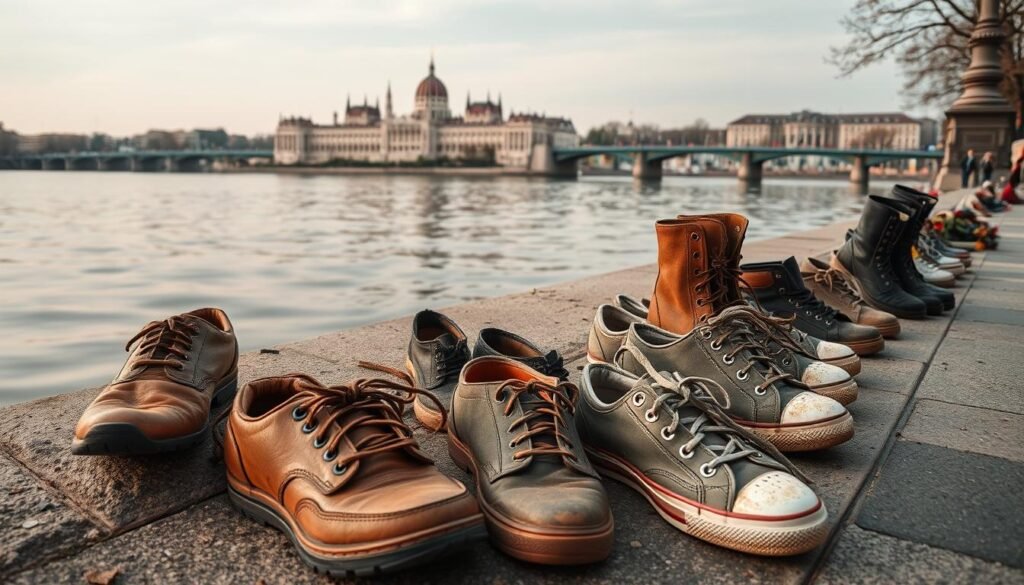
I stepped along the riverside and slowed my pace when the first iron shoes came into view. I gave myself a long, quiet minute before reaching for my camera. That pause helped me absorb the scene without turning it into a snapshot.
The memorial uses sixty true-to-life shoes anchored along the bank to honor Jewish victims shot by the Arrow Cross militia during 1944–45. Victims were forced to remove footwear before being killed and their bodies pushed into the river. The display is stark, direct, and designed for reflection.
Who the Arrow Cross were and why this matters
The Arrow Cross was a fascist group that terrorized the city during those years. This memorial makes history physical and immediate. It shifts the riverfront from grand views to a solemn reminder in a few steps.
I paired this stop with my Parliament walk; the change in mood felt deliberate and important. Mornings gave me the most space and silence. I recommend visiting early if you want privacy and respect.things-to-do-in-hilton-head
- Respectful behavior: no climbing, no loud music, and avoid blocking the shoes.
- Sixty pairs: each set represents a life and frames the bank’s edge visually and emotionally.
- Nearby spots to sit: benches along the promenade let you reflect before moving on.
| Item | Detail | Practical tip |
|---|---|---|
| Best time | Early morning | Fewer people; quieter reflection |
| What you’ll see | 60 iron shoes on the bank | Photograph respectfully or wait and absorb |
| Context | Arrow Cross executions, 1944–45 | Read plaques, consider nearby benches |
For a deeper account and background reading, I followed a linked piece that added context and personal stories: Shoes on the Danube Bank overview.
Fisherman’s Bastion at sunrise: views, terraces, and timing tips
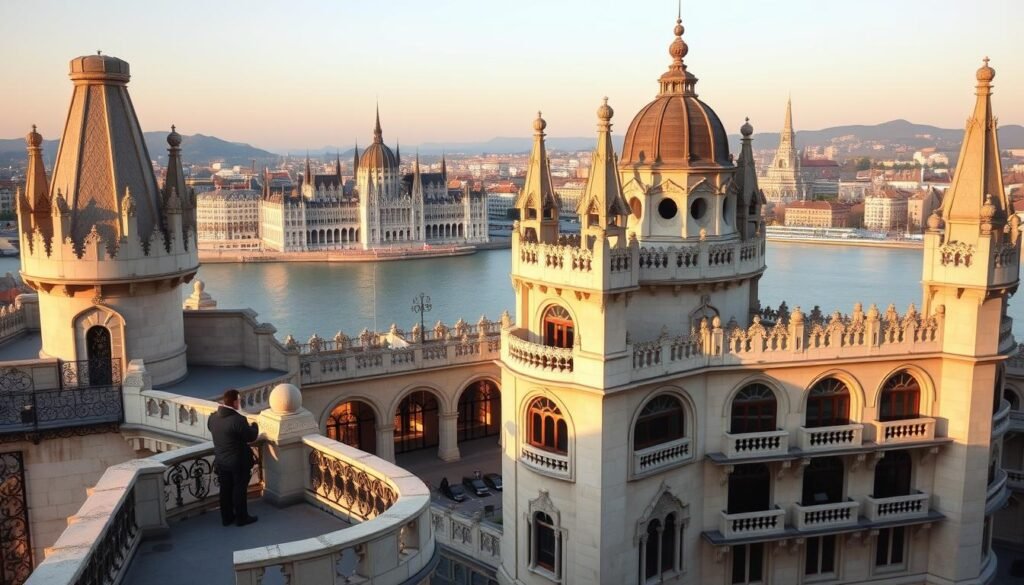
I woke before the city and walked up the hill for a quiet hour of light and empty arches. Arriving a few minutes before sunrise gave me the chance to pick an angle and settle into the scene without rush.
The lower levels are free and full of framed corridors that favor composition. Only the highest lookout terrace requires an entrance fee, which buys a packed plateau and wider panoramas across the Pest side.
Free areas versus paid lookout terrace
I used the free arcs for close-up shots and the stonework that leads your eye toward the river. When tour groups arrived, I slid into a quieter side corridor for a clean view and returned when the light reached its best minutes.
- I linked this stop with Matthias Church, then walked toward Buda Castle for the next part of my day.
- If clouds hid sunrise, I had a café nearby where I warmed up and waited for the sky to clear.
- My favorite moment was the city waking under the arches—small, hushed, and exactly why I came early.
| When | What to expect | Practical tip |
|---|---|---|
| Before sunrise | Quiet corridors, best soft light | Arrive 5–10 minutes early to choose a spot |
| After groups arrive | Busy highest terrace | Use lower levels or side arches for cleaner shots |
| Cloudy morning | Muted light, fewer colors | Visit café, return later for clearer views |
Buda Castle to the Chain Bridge: classic stroll on the Buda side
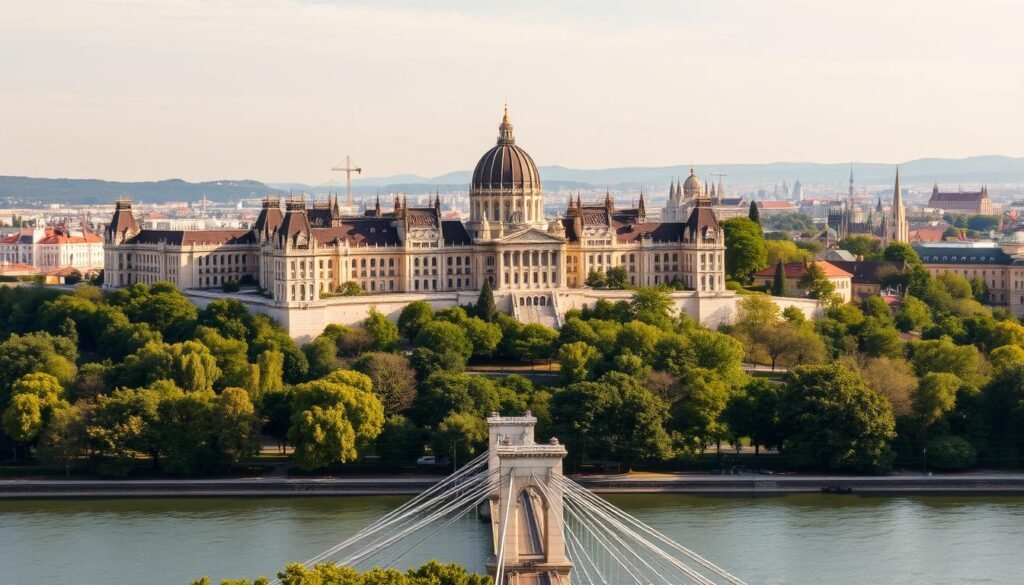
Night fell as I traced the quiet courtyards around the castle and plotted a slow descent to the Chain Bridge. The upper yards felt cinematic: statues and rooflines cut clear silhouettes against the sky.
I skipped the interior tour this time and instead focused on facades, light, and the easy loop down to the riverbank. That choice kept the walk nimble and let me catch blue-hour glows without rushing.
Courtyards, night ambience, and funicular ride details
I favored a route through the quieter courtyards where building shapes read well after hours. The funicular down to the Chain Bridge cost about €6 and gave a short, smooth ride—sit on the riverside bench for the best window view on descent.things-to-do-in-maui
“Cross the bridge slowly; pause mid-span for a panorama that frames both the Chain Bridge and the Parliament Building.”
Along the bank there are clear spots for framing both river and landmark in one shot. I noted safe, well-lit connectors that link the castle side and river walk so night photos feel secure and easy.
- Where I paused: upper courtyards for silhouettes and quiet.
- Why I skipped interiors: I wanted views, not a timed tour.
- Funicular note: short wait, sit riverside for framing windows.
- Night tip: stroll the bridge and stop mid-span for blue-hour panoramas.
| Item | Detail | Practical tip |
|---|---|---|
| Walk length | Short from Fisherman’s Bastion to castle periphery | Allow 30–60 minutes for courtyards and descent |
| Funicular | Fare ~€6, quick ride | Sit on the riverside for best views |
| Best photo spot | Mid-Chain Bridge, riverbank near the bridge | Visit at blue hour for combined Parliament and bridge framing |
| Food & warm drinks | Small cafés on the Buda side | Grab a quick bite before crossing back to Pest |
St. Stephen’s Basilica: inside the dome or street-side wow
![]()
I weighed a quick street-side look against buying the cupola ticket and letting light guide the choice.
I skipped the full climb once and entered another day. The main hall is richly decorated and the relic—the mummified right hand of St. Stephen—sits in a glass case that draws quiet attention. The interior felt solemn without being overwhelming.
If you pay the extra fee for the cupola panoramic view, the reward is literal: narrow stairs then a broad sweep of the city from above. The best way up is late afternoon when the low sun warms rooftops and the river glints.
Short on time? Stand in the square and approach from the south; the facade aligns perfectly with the open plaza and makes a strong photo without an entrance.things-to-do-in-honolulu
- Entrance: ticketed for the nave; add a cupola pass for skyline views.
- Relic: visible in the main hall, quietly displayed.
- Timing tip: pair this stop with a coffee on Andrássy or a walk back from Parliament.
| Option | Time | Best for |
|---|---|---|
| Main hall | 20–30 min | history and interior detail |
| Cupola | 30–45 min | panoramic city views |
| Square look | 5–10 min | quick facade photo without entrance |
Gellért Hill viewpoints: skyline panoramas after dark
![]()
I picked a quieter staircase on the southern slope and arrived at a lower lookout just as lights began to pop. The Citadella was fenced off for restoration, but the smaller towers gave me the wide panorama I wanted.
Citadella access notes: the fenced top area blocks the main terrace, so aim for the eastern and southern lower lookouts. They sit high enough for a clean line that frames both the Parliament and buda castle in one sweep.
Citadella access notes and safer paths after sunset
I walked up from the tram stop, followed the paved path that stays lit for several hundred meters, then switched to my phone light for a short dark stretch near the last switchback. The descent used a better-lit route on the river side; I chose that when I left.
- Packed light layers and grippy shoes; wind off the water made the skyline sparkle.
- If you’re uneasy after hours, visit during sunset hours instead—still glowing, less dark walking.
- Transit note: grab a tram or taxi at the base so you don’t backtrack along unlit paths.
Széchenyi Thermal Bath: how I do Budapest’s iconic water experience

I timed my visit for late afternoon so the steam rose into golden light and pools emptied a little. Széchenyi is vast: fifteen indoor baths and three outdoor pools, which meant variety without hopping between sites.
Locker vs. private cabin: standard tickets include a locker and shared changing. I found lockers fine for a short soak, but a private cabin felt worth the splurge when I wanted privacy and dry clothes afterward. Prices rose from about 6,200 HUF in 2023, so factor that into your plan.
What I packed and best time: flip-flops, a quick-dry towel, a refillable water bottle, and a small pouch for essentials. Weekdays late afternoon or cooler mornings gave me the smallest lines and the prettiest steam shots.things-to-do-in-lancaster-pa
Wellness add-ons: I skipped the beer spa this visit but noted the treatments menu for next time. Slot a 30–60 minute massage after your main soak so you leave relaxed, not rushed.
| Feature | Note | Tip |
|---|---|---|
| Indoor vs outdoor | Warm pools inside, hotter tubs outside | Alternate for steady energy |
| Entrance | Ticketed; price varies by day/time | Book online for less waiting |
| Etiquette | Quiet, no diving, towels on benches | Respect local rules and space |
Ruin bars 101: Szimpla Kert, Grandio, and the vibe of the Jewish Quarter
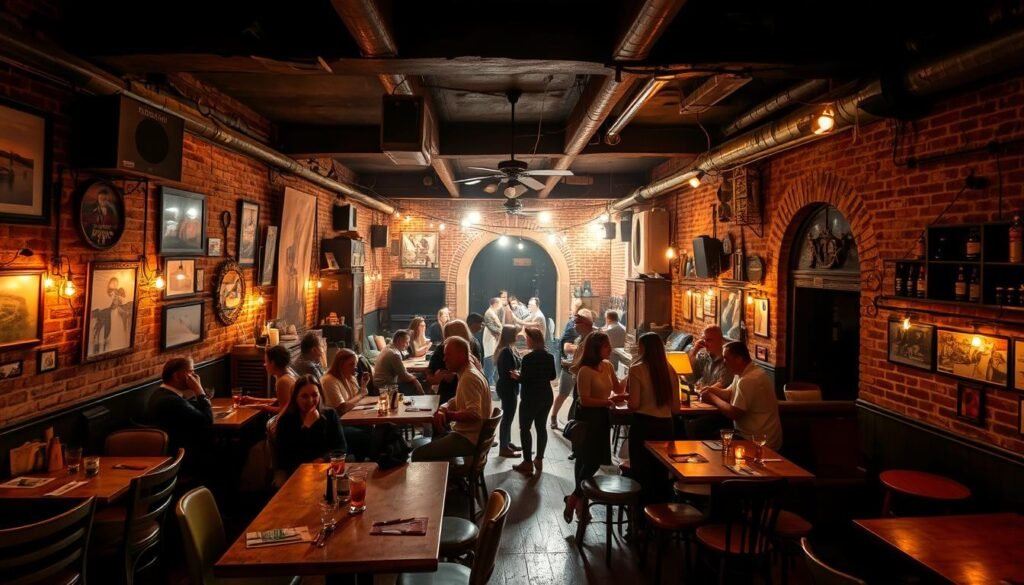
I began my first night when a local friend pointed me down an alley with a painted door and live music spilling out. The area felt improvised, alive, and oddly comforting.
Ruin bars grew from derelict flats and old factories into lively social hubs in the early 2000s. Szimpla Kert started the movement and still draws queues on peak nights. Grandio Jungle Bar sits nearby with a hostel crowd, a leafy courtyard, and a looser, party mindset.
What makes a ruin bar different
These spots use raw spaces and mismatched decor—think secondhand sofas, murals, and odd antiques. The result is playful, informal, and perfect for wandering between rooms.
Live music, lines, and late-night tips
I check Szimpla Kert first; if a line wraps the block, I pivot to a quieter courtyard bar or Grandio. Weeknights cut the tourist crowd and boost local bands.things-to-do-in-sedona
- Order first: I start with a local lager or a mixed spritz to settle in.
- Where I sit: Pick a corner bench for talking, a courtyard table for people-watching.
- When to move on: If the room grows cramped, head for another bar or try Instant when you want to dance late.
| Spot | Vibe | Hours tip |
|---|---|---|
| Szimpla Kert | Pioneer, busy | Arrive early or late for shorter lines |
| Grandio | Jungle courtyard, hostel scene | Better after midnight for fuller energy |
| Instant | Club, multi-room | Go if you want to dance past closing time |
Safety note: watch your belongings, plan a tram or taxi home, and keep a map app ready for late hours. That small planning kept my nights fun and stress-free.
Architectural walk down Andrássy Avenue: my favorite way to see the city
My favorite walk begins at the Opera and threads through side streets that hide tiny sculptures.
I start at the Hungarian State Opera House and let the avenue guide me toward the center. The broad street has an almost Parisian sweep, but the details feel uniquely local.
I hop off into alleys and pause at embassy facades. Those buildings reward slow eyes: carved lintels, brass plaques, and marble steps that invite a closer look.
Opera House, side-street gems, and embassy facades
I always slow by the Opera; its ornament hints at concerts and civic life across the years. Nearby courtyards often hide sculptures and doorways I never planned to find.
Szecesszió roofs: spotting the green and yellow tiles
The szecesszió movement reshaped many rooftops here. Watch for green-and-yellow tiles on the Museum of Decorative Arts and some religious buildings on the Buda side.
Once you notice those tiles, the pattern repeats across the avenue and side lanes. That small discovery links parks, galleries, and cafés in one pleasant arc.
“Walk from Városliget and drop by Széchenyi Baths afterward; the route moves from leafy park to ornate facades and then a warm soak.”
- Start at City Park (Városliget) and head toward the Opera.
- Peek into side streets for sculpted doorways and hidden courtyards.
- Spot szecesszió tiles on museums and older religious places.
| Segment | Highlight | Quick tip |
|---|---|---|
| Városliget start | Park, Széchenyi Baths | Link the walk with a bath visit for a full day |
| Opera stretch | Grand façades, embassy buildings | Pause for photos and step into side alleys |
| Central end | Cafés, boutiques, tiled roofs | Look up for green/yellow tiles and small statues |
Great Market Hall: food, paprika souvenirs, and tourist-trap smarts
The Great Market Hall felt like a city-sized pantry the moment I stepped inside. Light streams through the neo-gothic windows and stalls line the aisles with color and scent.
I map a short route before I shop so I can taste good bites and avoid the obvious tourist traps. I browse ground-floor stalls for paprika jars, cured meats, and small wine bottles that travel well.
Where I eat and what I skip: I sample lángos at a busy stall but skip over-priced plated meals that tack on hidden fees. If I want a quiet seat, I head upstairs to Fakanál restaurant, check the price board, and listen for live music before I sit.
- Watch the bill for extras like toppings and plates—ask first.
- Photogenic spots: the middle nave where light pools on wooden counters.
- Edible gifts: sealed paprika, fruit jams, and small wines pack safely.
Packing tip: cushion fragile bottles with clothing and double-bag spice pouches so souvenirs arrive home intact.
“Ask before they add extras; a quick question can save a surprise charge.”
What and where I eat: lángos, chimney cake, and coffee culture
I let snacks guide my wanderings, pausing where ovens or espresso machines called. My meals became a quick way to learn the city and its rhythms.
Retró Lángos: toppings, prices, and why it’s a must
I order the classic lángos with sour cream and cheese and a cold lemonade. The combo cost about 1,690 HUF and was worth every bite. Retró is the one place I tell everyone to try first when they ask where to find honest street food.things-to-do-in-waco
Molnár’s kürtőskalács: the chimney cake worth waiting for
Molnár’s draws long lines; I watch the dough roll and sparkle while I wait. A cake plus cappuccino ran about 1,800 HUF. For me, the warm sugar crust makes the line feel reasonable.
Stika, SixLetter, and breakfast that actually fills you up
| Spot | What I ate | Note |
|---|---|---|
| Stika | Hearty plate | Filling, great value |
| SixLetter | Specialty coffee | Stylish, small portions |
| Market detour | Snack & coffee | Quick bridge between stops |
New York Café: the gold latte and timing
I waited briefly for a window seat and ordered the 24-carat gold latte. The over-the-top building and live piano made lingering easy, though the price was high. When time was tight I grabbed lángos and skipped the long sit—each place serves a different mood and pace.
Nightlife beyond the bars: Gozsdu Courtyard and live music detours
I wandered into an open-air passage where live duos warmed the air and small plates passed between friends. Gozsdu Courtyard felt like a string of rooms under the sky—restaurants, pubs, and late spots that shift as the night grows.
My approach was simple: drift toward the music, then pick a bar where I could actually talk. I often started with a cocktail at one place, shared tapas at another, and moved on if the crowd grew loud.
Cocktails, tapas vibes, and neat detours
I liked Vicky Barcelona for live duos that punch above their size. If I wanted a club pulse later, Instant kept the night going. For quieter moments, I found side alleys or a bench away from the main flow.
- Hours: the area wakes after 9 PM and peaks around midnight.
- People flow: pick earlier shifts if you want seats, later if you seek energy.
- Alternative: swap one late night for a post-dinner soak at the baths when you need calm.
- Homeward tips: grab a tram, taxi, or rideshare—keep a map app and local tram numbers handy.
For more on the neighborhood and nearby highlights, see my Jewish Quarter guide.
All the essential things to do in budapest for a short trip
I built a two-day rhythm that packed major sights without rushing the moments that mattered. This plan clusters walks so you spend minutes at highlights, not hours lost between them.
My two-day hit list with walking clusters
Day 1: Start at Fisherman’s Bastion at sunrise, move to Buda Castle and ride the funicular down to the Chain Bridge. Cross for midday at the Parliament Building and slot the Shoes on the Danube memorial as a quiet stop.
Day 2: Thread Andrássy Avenue toward Heroes’ Square via City Park, visit the Great Market Hall for snacks and souvenirs, then end with a late soak at Széchenyi thermal baths.
- Pace: pad each stop with 15–30 minutes for photos and breaks.
- History note: the Shoes Danube memorial recalls Arrow Cross actions—approach with respect.
- Nightlife: pick a calm live-music bar or go full energy at ruin bars like Szimpla Kert or Instant.
- Prebook: museum hours and major baths fill fast; book big-ticket tours, play smaller visits by ear.
Practical travel notes: hotels by the river, money, and local phrases
A room with a Danube-facing window turned my evenings into a slow, framed postcard. I like hotels that put me within a short walk of the Chain Bridge, Fisherman’s Bastion, Parliament, and Buda Castle. The InterContinental (IHG) and Budapest Marriott are my go-tos for easy walking access and reliable views.things-to-do-in-athens
Where I like to stay near the Danube
Staying riverside shrinks transit time and gives quick access for dawn and dusk walks. Those hotels save me steps and let me rest between loops without hunting transport.
Money, tipping, Unicum and a quick “köszönöm”
I split payments: cards for hotels and big meals, small cash for markets, taxis, and tips. Tipping 10–15% is common at restaurants. I finish meals with Unicum, a bitter herbal digestif that locals sip after dinner.
Phrase toolkit: “köszönöm” is a short, polite thank-you that opens many doors. Use it when a server hands your change or a shop assistant helps pack a paprika souvenir.
Packing & transit notes: After a few years of city travel I always bring layers, comfy shoes, a compact umbrella, and a phone ticketing app. For airports I prebook a shuttle or confirm a metered taxi so arrivals stay simple.
| Item | My tip | Why |
|---|---|---|
| Hotel choice | InterContinental or Marriott | River views and walkable loop |
| Payments | Card + small cash | Cards cover big bills; cash for stalls |
| Packing | Layers, shoes, umbrella | Comfort across seasons |
Conclusion
Conclusion
What made the trip sing was a simple rhythm: a dawn terrace, a quiet memorial, a long soak, and an evening ruin bar. I threaded those moments into short walks and a river crossing. That balance kept my days moving without rush.
I would visit Fisherman’s Bastion again at sunrise, spend a silent minute at the shoes memorial, and book another session at the thermal baths. I’d explore the castle more deeply and seek a fresh angle on Parliament next time.
Start by picking one place that sparks you. Build a two-day route around that feeling and let the city unfold at your pace.


